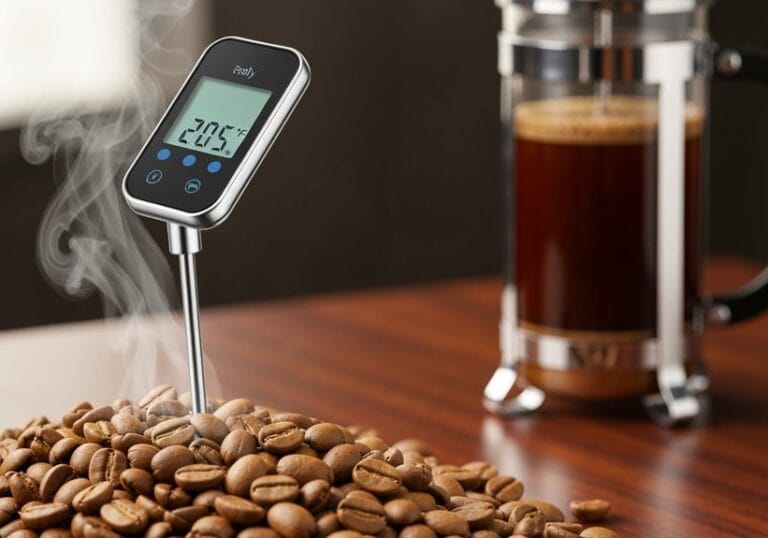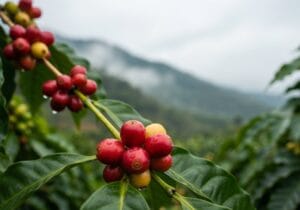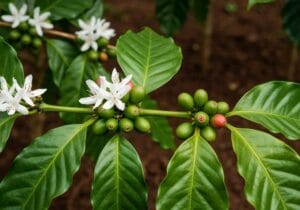To nail that perfect medium roast, keep your temperature between 210°C and 220°C—think 410°F to 428°F, which is hotter than most summer days! Too low, and it’s a sad, weak brew; too high, and hello, carbonized disaster! It’s like Goldilocks: not too hot, not too cold—just right! You’ll develop that yummy fruitiness and chocolate hints. Oh, and there’s more to this coffee magic—just stick around for some brewing tips that’ll make your cup sing!
Key Takeaways
- Set your roasting temperature between 210°C and 220°C (410°F to 428°F) for achieving a balanced flavor profile.
- Monitor the roast closely to avoid carbonizing the coffee by exceeding the temperature limit.
- Adjust roasting time to enhance sweetness while maintaining desirable acidity in the flavors.
- Use proper equipment to ensure consistent temperature control during the roasting process.
- Experiment within the ideal temperature range to find your perfect medium roast flavor.
Optimal Roasting Temperature for Medium Roast Coffee
With regard to roasting medium roast coffee, you’ve got to get that temperature just right—it’s like Goldilocks and the three bears, but instead of porridge, it’s about not burning your precious beans!
For those aiming for that perfect roast profile, you need to stay between 210°C and 220°C (that’s 410°F to 428°F for the Fahrenheit fans out there), where magic happens without straying into burnt territory. Balanced acidity and sweetness play a critical role in achieving the ideal flavor profile for medium roast coffee. Too hot? Yikes! You risk carbonizing your coffee. With the right temperature control, you’ll develop those delicious flavors, like mild fruitiness and chocolate hints.
Impact of Roasting Time on Flavor Profile
Roasting time struts in like the main character at coffee’s flavor party, and boy, does it know how to make an entrance! Seriously, it’s a game changer.
A longer roast? It breaks down those pesky organic acids, giving you a sweeter, fuller-bodied cup—perfect for espresso lovers. But if you’re after that bright, fruity zing, a quick roast is your ticket. You’ll amp up those berry and chocolate aromas!
Just beware: go too fast, and you might mute the flavors we all love! It’s a dance of aroma development and acidity balance; too much time increases sweetness but can mute brightness. Recent studies show that optimal growing regions are critical for flavor outcomes, too.
Balance is key: rush the roast and risk dulling those beloved flavors; savor the dance between sweetness and brightness!
In short, finding that sweet spot is like threading a needle—tough but oh-so-rewarding!
Brewing Temperature Considerations

How exactly does one find the sweet spot when brewing a medium roast? Well, grab your thermometer—because we’re aiming for that snug temperature range of 88°C to 93°C (190°F to 200°F).
Too hot, and you’ve accidentally brewed a bitter nightmare; too cold, and you might as well be sipping on dishwater! Maintaining temperature stability is essential for that perfect extraction balance.
You don’t want those poor flavor notes—like nutty goodness and caramel hints—getting overcooked! Pour-over aficionados should cool your boiling water for about 30 seconds for the best brew.
And hey, if it goes well, you can brag about your impressive coffee prowess! But if not, just blame it on the beans, right?
Chemical Composition Retained in Medium Roasts
Regarding medium roasts, a surprising world of chemistry is buzzing beneath the surface!
Who knew coffee could be such a science project? While you sip that steaming cup, keep in mind that caffeine is hanging around—about 1.10–1.24% by weight, so don’t blame the jitters on your neighbor’s dog!
Certain acids like chlorogenic remain, offering both a tangy kick and antioxidant properties, which sounds fancy, but really just means it’s good for you.
As for the melanoidins—those lovely brown compounds that pop up during roasting—they enhance color and antioxidant activity.
Plus, let’s not forget those complex carbohydrates giving your coffee that delightful body, while also showing off some sweet undertones, making every sip an unexpected chemistry lesson!
Frequently Asked Questions
Can I Use Regular Coffee Machines for Medium Roast Coffee?
Regular coffee machines are suitable for medium roast coffee. Diverse brewing techniques can optimize flavor, even with fixed temperatures. Adjusting grind size and coffee-to-water ratios can further improve extraction, ensuring satisfying results from different coffee machine types.
What Beans Are Best for Achieving a Medium Roast?
Arabica beans are ideal for achieving a medium roast due to their complex flavor profiles and balanced acidity. While Robusta beans can add body and lower acidity, they often lack the nuanced flavors preferred in medium roasts.
How Do I Know When Coffee Is Medium Roasted?
To identify a medium roast, one must observe the beans’ medium brown color development and assess the flavor profile, which typically balances sweetness, acidity, and body, reflecting a smooth, mellow taste with low bitterness.
Is There a Specific Humidity Level for Roasting?
A specific humidity level during roasting is essential; ideally, green coffee beans should maintain 10–12% moisture. Proper humidity effects directly influence roasting balance, ensuring ideal flavor development and minimizing defects during the roasting process.
Can I Adjust Roasting Temperatures for Different Coffee Origins?
Yes, roasting temperatures can be adjusted based on coffee origin. Different roasting profiles improve unique characteristics, as denser beans may require higher temperatures, while lower-density origins benefit from gentler heat during the roasting process.





